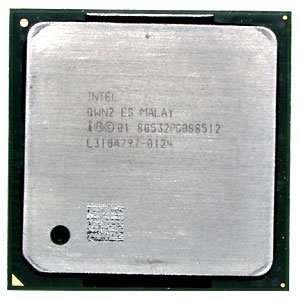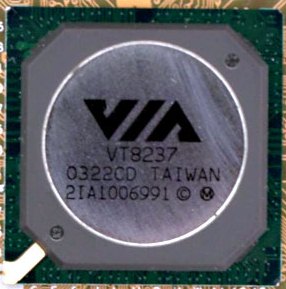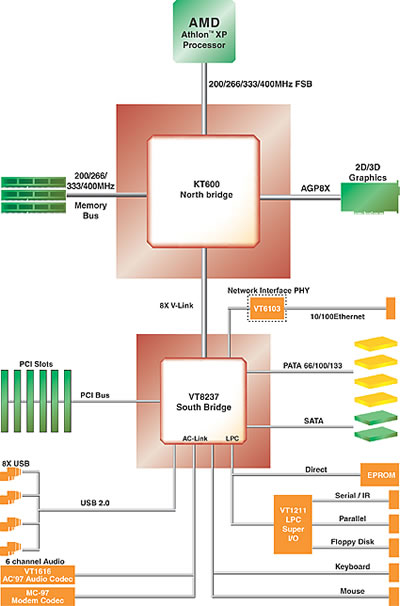 |
||
|
||
| ||
As we had promised, the new stage of "Intel vs. AMD" blockbuster was finally born in our lab, so we can offer it to your impartial justice. We must say that despite the theme is very hot, we have decided not to generate tension. Otherwise it would cause a chain reaction, involving our readers and resulting into a long forum flame. So our blockbusters are now going to be calmer and, who knows, maybe readers won't be getting angry after hearing anything about Intel and AMD processors comparison. On the other hand, we decided that reviews should not only simulate negative feelings, but some positive things as well. So, we'll turn to varieties of minor tasties like review methods revisions, test renewal, new readout templates and other really useful things. As for the heroes of the review, as you might have guessed, they are 3.2GHz Pentium 4 and Athlon XP 3200+ processors. The latter is already familiar to you, and the former... The former differs from 3.0GHz Pentium 4 only by 200MHz higher clock speed. It's not that fundamental to be pompous about it, so we just state the clock speed increase and offer you the photos. Especially, we have another "hero" to be tested today. It's the long anticipated VIA Apollo KT600 chipset. Let's speak of it in detail first.   VIA Apollo KT600: "a gouty revolutionist" Frankly speaking, the latest Socket A chipsets from VIA Technologies make
the author of this laugh sometimes even hysterically. Let's introduce our newcomer
on the background of its predecessors. Features in square brackets we declared
at the moment of chipset announcements, but disappeared with time. A very interesting
summary we have here...
  So, we see that in the person of KT400A we have finally got what we should have got with KT400 together with "vinyl AC'97" and slightly improved Southbridge. VIA KT600 adds to KT400A features the 400MHz FSB and new Athlon XP support and a new Serial ATA-enabled Southbridge. Frankly speaking we'd like to refuse VIA Technologies' official statement of North-/Southbridge one-to-one relationship and declare: this doesn't comply with reality at all. One can freely argue that a half of all mobos to be sold within a couple of months, will feature "vinyl audio", Serial ATA, etc. completely independently of the chipset. Just because VIA-based mobo makers always strived to implementing the latest Southbridge and VIA didn't want or couldn't do anything about this. So, we can say that VIA KT400A is completely identical to KT400 (oh yeah it's faster... but couldn't they provide this from the very beginning?). And KT600 differs from the former two by the "epochal" 400MHz FSB support. Still, there are also three proprietary technologies worth mention. FastStream64. Using extended (we guess it's just larger) prefetch buffers array it should reduce latencies and speed up the interaction with memory. This technology was announced as far back as with KT400A to become something like an nForce2 counterpoise. Well, as we are already aware of the test results... It must've been a good idea. We guess. Anyway, everything is described below in the test part. VIA Vinyl Six-TRAC Audio. An older VT1616 codec named VIA Vinyl Six-TRAC, connected via standard AC'97 interface. This marketing breakthrough has nothing to do in specs, as the Southbridge hasn't been redesigned "for" Vinyl Audio and will work perfectly with any other standard codec similar to the first KT600-based mobo tested in our lab. Integrated Serial ATA with RAID. VT8237 is actually VIA's counterpoise
to Intel ICH5R, featuring up to 8 USB2.0 ports and corresponding Serial ATA: two
ports for SATA devices supporting RAID 0, 1 and 0+1 (the latter is still absent
in rival products). It would be strange if VIA hasn't provided this. After all
it has been making more functional Southbridges than Intel before, so why lagging
behind this time?  And now, may you excuse us for an indelicate question: doesn't this endless KT400 modification bother you? Because it does bother us. So, we finally introduce the KT600 flowchart to turn to the tests. As for the flowchart, here's a riddle: how do you think, does it has any fundamental distinction from a variant for... VIA Apollo KT266? All who know the answer can get a nice candy. Performance examinationTestbed:
Software:OS & drivers:
Test apps:
Test resultsSynthetic and game 3D apps3DMark2001 SEVery nice jaggies: single-channel systems loose in both cases, Pentium 4 wins and Athlon XP + VIA KT600 loses. As we still pretend we don't know the next results to make things more interesting, this chipset unpleasantly surprises us. Where's the adequate competition with NVIDIA? On the other hand, the traditional difference between the performance of the same 3.2 GHz Pentium 4 on i845PE and i875P is impressive. Here we see that rare case when faster memory subsystem provides actual boost. In its best variant (with nForce2 Ultra 400) Athlon XP loses Pentium 4 + i875P about 7%. Not that fatal, but still considerable. We'll just say that a 6-9% lag won't turn away an Athlon XP fan, might slightly turn a neutral to Pentium 4, and will surely laughed over in the Intel camp. Where you belong is up to you to decide... 3DMark03 This graphics summary reminds the previous, but shows less difference between
the competitors, relying more on graphics. The older 3DMark2001 SE seems to be
too easy for NVIDIA GeForce FX allowing platforms to show themselves. And CPU Marks results are almost identical to the relative 3DMark2001 SE numbers that again proves the CPU dependence of this old test. Return to Castle Wolfenstein and Serious SamHere we see that performance is strongly tied to engine "predisposition" to either CPU core: in Return to Castle Wolfenstein Pentium 4 stays near the fastest Athlon XP even on older i845PE. Serious Sam 2 shows the approximate parity of single- and dual-channel systems. Remembering the past of these two processor lines we wonder, if we should be happy that Intel's top model has finally reached the rival in the "AMD game", or sad about the clear standstill in the AMD desktop camp. SPECviewperf 7.1Can't say this is a game test, and, in general, the importance of its results for end users is questionable. But still 3D synthetic is useful in its own way. The subtests resulted in a very interesting situation (we traditionally chose those, which introduce the biggest platform differences). First, there's drv-09, which likes fast-memory systems. As the required computing performance of both processors is similar, we clearly see two pairs. In its turn, dx-08 subtest shows obvious inclination to specific CPU architectures, or rather antipathy to others. And though it may seem strange, it's not only about the aforementioned long pipeline and other known Pentium 4 disadvantages. Athlon XP wins it since this subtest (or rather it's predecessor) has disliked Northwood's increased cache. We would naturally like to offer you counterpoise results from some other subtest "obstructing" Athlon XP, but it doesn't seem possible for now. Data compressionMP3 (Lame codec)As we've proved long ago, given the same architecture, Lame's audio encoding performance depends purely on clock speed, with memory subsystem having almost no effect. Amusing, but nForce2 has lost unexpectedly on Socket A. We guess it's high time to revise history and remember the strange test results on the first nForce. Is it some partial incompatibility of codec algorithm and DASP? Anyway, it's almost impossible to prove or disprove this or any other suggestions. MPEG4 (DivX)DivX video encoding resulted in opposite. This software is sensitive to memory subsystem performance. This is best seen... Well, this is best seen on the example of our "scapegoat", VIA KT600. As it might have sounded before, "We hope the motherboard was been damaged during the delivery" :). Otherwise, we can't name it anything else, but a "slow". But, let's turn to winners. This time it's Pentium 4 for sure (naturally together with i875P): it outrun Athlon XP + nForce2 by 10% making the victory absolute. Though AMD fans might still say it's a trifle. :) Archiving (WinAce and WinRAR)Two different apps showed similar results. Without taking into account the absolute difference, it's almost identical, as archivers are very sensitive to memory subsystem (look at the results of same CPUs on different chipsets). 3.2GHz Pentium 4 outruns Athlon XP 3200+ considerably again. Its 800MHz FSB is a real benefit that naturally exceeds 400MHz FSB of AMD's top model. Professional graphics3ds max 5.1We have at last updated the version along with the test scene, so it fully utilizes 3ds max 5.1 features now (including the specific lightning, etc.). Speaking of results we'd prefer to pass VIA KT600. In general, single-channel chipsets lagged by several percent in this memory-insensitive test. Comparing the results of nForce2 with Socket 478 results doesn't give us any new info. Pentium 4 has been winning in 3ds max since version 4.26, and so it continues today. The reason has been explained a thousand times: they've started to adjust the rendering engine for Pentium 4 since that version exactly. (We've checked this on our old test scene and received almost identical relative results.) Photoshop 7.0This is a newcomer, as we haven't tested processors in Photoshop before, so let's pay some attention to the method. This is actually a script (or "Action" in terms of Photoshop), created according to recommendations from this page. We had been looking towards making such a thing, but visited this page completely by chance (on receiving a link from our friends, who knew we were examining PC performance). Its contents impressed us by accessibility and logic. So, we decided it's the right test script for Photoshop we were looking for :). As for the original script, its author just created it for slower systems, we guess, so it was performing very fast on our test beds, making testing uncomfortable. But let's now get back to the results: nothing surprising, we must admit. Pentium 4 is clearly better, but the difference is not that considerable to shout about. The top Athlon XP on nForce2 loses by about 12% (as you remember, KT600 "hors concours" :)). CPU RightMarkEquationsOr, in other words, physical model calculation. Those who interested in (or just use) the CPU RM pack should know that the "Solver" supports two optimization types: for usual FPU and SSE2 instructions. The diagram shows the results of them both (of course, SSE2 is supported by Pentium 4 only). You can see that Intel's processor loses in the x87 FPU field, but the lag is not that significant, as before. It's the matter of still larger clock speed gap between it and Athlon XP. And SSE2 pushes Pentium 4 even further forward. But what's more interesting, is the boost provided by SSE2. It makes the whole +44%! Almost by one and a half! We guess this is the final argument for software developers optimizing their code for Pentium 4: what other processor can "suddenly" offer such a boost?.. Still, we can look at this from another angle: what other processor is so weak on the standard x86 code, so it requires additional efforts (which is not always possible/comfortable) to expose its potential. RenderingHere we were mostly interested in the boost provided by the "second virtual processor", i.e. Hyper-Threading, as this part was specially optimized for Intel's new initiative. And what is really amusing that nothing but Hyper-Threading helps Pentium 4 to win here! Despite Athlon XP 3200+ loses in the single-threading mode as well, the difference is not that great (at least for a synthetic test). But parallelizing just invokes Pentium 4's "hidden weapon" that increases its performance. The boost makes about 16% that is very good for an actually "free" addition, especially considering the slowdown of the "classic" AMD processor. Low-level cache and memory testsRead/write speedPreviously we had used Cachemem to estimate the "pure" memory performance, but the necessity of running from DOS along with the age of this app was making us search for an alternative. And it seems we have finally found it in the person of CacheBurst32 (a domestic product, by the way). So, the read speed (don't be startled, it's true): using SSE (to maximize read speed) Pentium 4 outruns Athlon XP on nForce2 by almost three times! But we guess it's not only about the memory subsystem performance, but also about the FSB. As for VIA KT600, we'd like not to mention it... The write speed enables AMD platform to catch up with the leader. And this makes us wonder why Pentium 4 with its "super fast" bus gives way so suddenly? LatenciesIn brief, nForce2-based system is almost an all-round leader here. AMD should thank God that NVIDIA doesn't make chipsets for Pentium 4 :). The only time Intel's products outran rivals was fine pitch read test. But it's the most synthetic test simulating least possible conditions. Everything else was won by... neither Athlon XP (nor Pentium 4), but NVIDIA nForce2. Finally, introducing the performance summary of the both top rivals:
ConclusionsAs long as we announced the comparison of two rival processors, we'll make our conclusions accordingly. They are mostly obvious and remind the previous reviews. Wording differences are caused not by our intention to say something new, but rather the short memory regarding the previous conclusions :). 3.2 GHz Pentium 4 bce Še prevails over Athlon XP 3200+. The defeat is not that fatal, so AMD fans may say it's inessential and unimportant. For the sake of justice, this interpretation has its right to live, as there are no strict definitions of "inessential" and "unimportant". And emotionally the gap between top models of two companies doesn't provoke rejection. We'd only like to remind that Athlon XP already seems to feature all improvements possible for its core: FSB is maximized to the limit (we guess it's barely possible to raise it more in serial models); L2 cache is already 512Kb (and there's not much sense in adding more to it); finally, the clock speed has been lagging around 2.2GHz for so long, that it will hardly manage another 100MHz addition. Today all of the above provided AMD with a processor, more or less comparable with 3.2GHz Pentium 4, and this is very good. On the other hand, Pentium 4 will soon have its Prescott core with 1Mb L2 cache, improved Hyper-Threading and other performance boosters. It seems AMD will be able to compete with Intel only by releasing its long-anticipated Athlon 64. As for the third hero of our review, the newest VIA KT600, we'll refrain from
any comments for now. It looks very weak on the background of "competing
dual-channel solutions". In the nearest future we await the comparison of
KT400, KT400A and KT600 to make their positions clear, and hope we'll have more
understanding of VIA's latest product performance. Write a comment below. No registration needed!
|
Platform · Video · Multimedia · Mobile · Other || About us & Privacy policy · Twitter · Facebook Copyright © Byrds Research & Publishing, Ltd., 1997–2011. All rights reserved. |